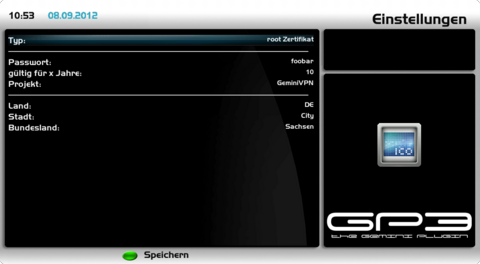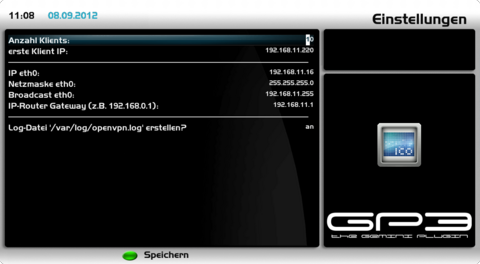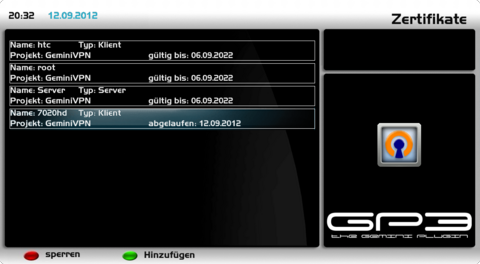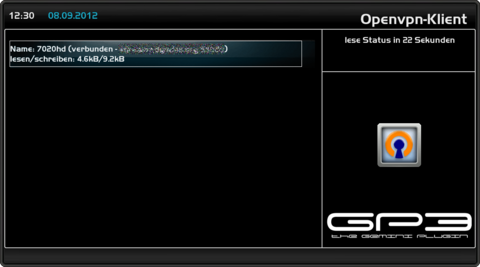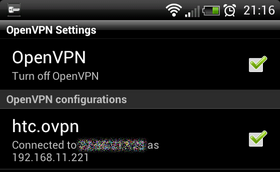GP3.2 OpenVPN (en)
InhaltsverzeichnisAfter installing the geminiopenvpn Plugin you have an OpenVPN Server or Client which is easy to configure. The plugin uses certificates (Server-Multi-Client). The connection on the OpenVPN Server is made over an encrypted TLS connection. For connections the OpenVPN Server Plugin creates a virtual network interface (tap0), which is connected over a network bridge (br0) with the internal network adapter (eth0) of the Dreambox. One or more OpenVPN clients get an IP adress of the internal network and can access all availiable services without additional routing. The mode used by OpenVPN is Bridging. With this mode the Broadcasts are forwarded without any problem. Same for network protocols like IPv4, IPv6, Netalk, IPX, ...
Requirements for using OpenVPN
OpenVPN ServerInstall the OpenVPN Plugin via BluePanel and configure the Server as described. After rebooting you find the OpenVPN Server (and client) in the BluePanel. It's also possible to install the plguin over the console with the following command: opkg update && opkg install geminiopenvpn
Create Root CertificateNow we create the keys and certificates for the Certificate Authority (CA). Open the OpenVPN Server Plugin and push the [green] button for certificates. Choose root-certificate and change the settings as described in the list. For all parameters only letters and numbers can be used.
Save the settings with the [green] button. The corresponding files will be created and saved in the directory /etc/ssl/openvpn. Back to table of contents
Create Server CertificateOpen the OpenVPN Server Plugin and push the [green] button for certificates. Push again the [green] button and choose as type the setting Server and change the settings as described in the list.
Save the settings with the [green] button to create the certificates. You will be prompted to enter the password (which was entered while creating the root certificate). When a wrong password is entered the following error message is displayed: can't generate certificate. When the correct password is entered the certificates, keys and the Diffie-Hellman parameters are created. This can take some minutes (up to 30 min), the status is displayed in the plugin. The plugin can be closed while the creation is in progress, the process continues in background.
Create Client Certificate(s)Open the OpenVPN Server Plugin and push the [green] button for certificates. Push again the [green] button and choose as type the setting Client and change the settings as described in the list.
Save the settings with the [green] button to create the certificates. You will be prompted to enter the password (which was entered while creating the root certificate). When a wrong password is entered the following error message is displayed: can't generate certificate. When the correct password is entered the cleint certificate, key and config file can be found in the following directory: /etc/ssl/openvpn These files (three files for each client) will be used later on the OpenVPN clients to set up a connection with the server. The needed files look like follows, e.g. if the entered name was 7020hd. In addition to the three files every client needs the Root Certificate (vpn-ca.pem).
Overview of the configurationThe created configurations can be displayed with the [green] button (certificates) in the OpenVPN Server Plugin. The example shows the configuration for a root certificate, Server settings and the configuration of two clients, with the names htc and 7020hd.
SettingsOpen the OpenVPN Server Plugin in the BluePanel under the daemons. Now we check first the settings, before starting the OpenVPN Server. Push the [blue] button and choose the point [Settings]. Use the following list for the descriptions and modify if requires. The network settings should be taken from the Dreambox and should only be changed in rare occasions.
Save the settings with the [green] button. After saving the settings the OpenVPN Server is started automatically. The OpenVPN Server will also be started automatically after restarting the Dreambox, when a config file and certificates are available.
OpenVPN Log FileInformations about the status of the OpenVPN server can be displayed with the [red] button (Log file). The example shows the OpenVPN server was started succesfull with two connected clients. The log file can also be displayed in the terminal with the following command: cat /var/log/openvpn.log
Overview of connectionsThe OpenVPN Server Plugin controls regularly if clients are connected and shows the connections as in the image Active connections. In this example two clients are connected, with the name htc and 7020hd.
Block certificate(s)Certificates can be blocked, when you want to deny access from a client. Blocking is done over the [red] button, when the menu of the certificates is opened. Blocked client certificates are displayed as expired. For blockin the correct passwort (which was used for creating the root certificate) needs to be entered.
OpenVPN Server - Menu buttonOpen the OpenVPN Server Plugin and push the [blue] button of the remote control. The functions are described in the following list.
Delete certificatesCertificates can not be deleted in the OpenVPN Server Plugin. The files need to be deleted manually in the directory: /etc/openvpn/ssl
OpenVPN KlientEs gibt viele, verschiedene OpenVPN Frontends, für die einzelnen Betriebssysteme, um Verbindungen auf einen OpenVPN Server zu erstellen. Die folgenden Abschnitte beschrieben die Konfigurationen des OpenVPN Klients der Dreambox (mit GP3.2 Plugin) und einem Android basierenden Smartphone.
Dreambox als KlientBeim Einrichten des OpenVPN Klients, müssen die erstellten Klient Dateien (4 Stk.) von der Serverbox kopiert und in das folgende Verzeichnis der Klient Dreambox eingefügt werden: /etc/openvpn Hier nochmal eine Auflistung der vier benötigten Dateien für den OpenVPN Klient. Das xxx steht für den Namen, welcher bei der Klient Erstellungen eingegeben worden ist.
Konfigurationsdatei editierenBevor eine Verbindung aufgebaut werden kann, müsst ihr die Konfigurationsdatei (*.ovpn) editieren. Beim der Zeile remote muss die IP-Adresse oder Hostadresse und der korrekte Port eingetragen werden. Die Konfiguration könnte wie folgt ausschauen, wenn der Zugriff über den Hostnamen webaccess.dyndns.tv erfolgt via Port 1194. .
.
# example 'remote foobar.org 1194'
# example 'remote 97.123.100.236 1194'
remote webaccess.dyndns.tv 1194
resolv-retry infinite
nobind
persist-key
persist-tun
.
.
Verbindung aufbauenÖffnet das OpenVPN Client Plugin im BluePanel unter den Daemons. Im Plugin erscheint ein Eintrag (nicht verbunden), wenn die Konfigurationsdateien in das korrekte Verzeichnis kopiert worden sind (/etc/openvpn). Startet die Verbindung auf den OpenVPN Server mit der [OK] Taste. Funktioniert alles, dann erscheint der Status verbunden im OpenVPN Client Plugin. Trennen könnt ihr die Verbindung durch erneutes drücken der [OK] Taste.
Android Smartphone als KlientDas Bild zeigt ein Beispiel von einem Android basierenden Smartphone, welches mit der Dreambox verbunden ist. Als App wird OpenVPN settings eingesetzt, um die Verbindung zum Server zu starten. Beachtet, dass das Gerät gerootet sein muss, um OpenVPN zu nutzen. Weiters wird der tun/tap Treiber, die Busybox und OpenVPN benötigt. Bei vielen Custom-Roms sind diese Abhängigkeiten schon in der Firmware integriert. Die Konfigurationsdatei (*.opvn) muss korrekt angepasst werden mit dem Remoteserver und dem entsprechenden Port ergänzt werden. Kopiert anschliessend die Klient Dateien auf die SD-Karte, z.B. in einen erstellten Ordner openvpn. Jetzt müsst ihr nur noch die OpenVPN settings App anpassen (z.B. Pfad zu Konfiguration, Zertifikaten) und der Tunnel auf den OpenVPN Server kann gestartet werden.
Support threadIf you need help with OpenVPN, follow the link ;) geminiopenvpn
|
